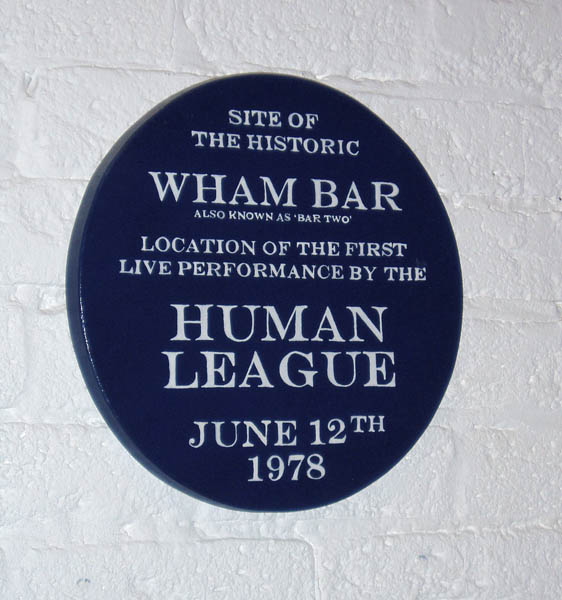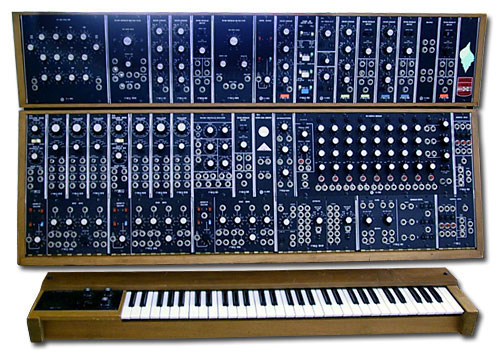|
Roland SH-3A
The SH-3A is a monophonic analog synthesizer that was manufactured by Roland from 1975 to 1981. It is unique in that it is capable of both the usual subtractive synthesis and also the less common additive synthesis, offering mixable waveforms at different footages. Two LFOs and a unique sample-and-hold section provided capabilities not found in competing self-contained synthesizers of the time. The SH-3A was Roland's first non-preset based synth. The predecessor, the Roland SH-1000, could also do this but didn't offer as much control as on the SH-3A. The rhythmic pulsing in the Blondie song " Heart of Glass" is an example of its sound. Contrary to common belief, the initial version "SH-3" did not infringe on the transistor ladder-filter patent of Robert Moog. It used a diode filter like the EMS VCS 3. The SH-3A does use a transistor ladder-filter and as a result can generate Moog-like sounds. Notable SH-3A users * Blondie * Chris Carter * Covenant * The Human League * Radi ... [...More Info...] [...Related Items...] OR: [Wikipedia] [Google] [Baidu] |
Analog Synthesizer
An analog (or analogue) synthesizer is a synthesizer that uses analog circuits and analog signals to generate sound electronically. The earliest analog synthesizers in the 1920s and 1930s, such as the Trautonium, were built with a variety of vacuum-tube (thermionic valve) and electro-mechanical technologies. After the 1960s, analog synthesizers were built using operational amplifier (op-amp) integrated circuits, and used potentiometers (pots, or variable resistors) to adjust the sound parameters. Analog synthesizers also use low-pass filters and high-pass filters to modify the sound. While 1960s-era analog synthesizers such as the Moog used a number of independent electronic modules connected by patch cables, later analog synthesizers such as the Minimoog integrated them into single units, eliminating patch cords in favour of integrated signal routing systems. History 1900–1920 The earliest mention of a "synthetic harmoniser" using electricity appears to be in 1906, cre ... [...More Info...] [...Related Items...] OR: [Wikipedia] [Google] [Baidu] |
EMS VCS 3
The VCS 3 (or VCS3; an initialism for ''Voltage Controlled Studio, version #3'') is a portable analog synthesizer with a flexible modular voice architecture introduced by Electronic Music Studios (London) Limited (EMS) in 1969. EMS released the product under various names. Logos printed at the console's front left (see photos) say "V.C.S. 3" on the most widely sold version; "The Putney (VCS 3)" on the earlier version; and "The Synthi (VCS 3) II" on the later version (Synthi VCS 3 II). History The VCS 3 was created in 1969 by Peter Zinovieff's EMS company. The electronics were designed largely by David Cockerell, and its distinctive appearance was the work of electronic composer Tristram Cary. It was one of the first ''portable'' commercially available synthesizers, in the sense that it was housed entirely in a small wooden case, unlike synths from American manufacturers such as Moog Music, ARP and Buchla, which had large cabinets and could take up ... [...More Info...] [...Related Items...] OR: [Wikipedia] [Google] [Baidu] |
Analog Synthesizers
An analog (or analogue) synthesizer is a synthesizer that uses analog circuits and analog signals to generate sound electronically. The earliest analog synthesizers in the 1920s and 1930s, such as the Trautonium, were built with a variety of vacuum-tube (thermionic valve) and electro-mechanical technologies. After the 1960s, analog synthesizers were built using operational amplifier (op-amp) integrated circuits, and used potentiometers (pots, or variable resistors) to adjust the sound parameters. Analog synthesizers also use low-pass filters and high-pass filters to modify the sound. While 1960s-era analog synthesizers such as the Moog used a number of independent electronic modules connected by patch cables, later analog synthesizers such as the Minimoog integrated them into single units, eliminating patch cords in favour of integrated signal routing systems. History 1900–1920 The earliest mention of a "synthetic harmoniser" using electricity appears to be in 1906, cre ... [...More Info...] [...Related Items...] OR: [Wikipedia] [Google] [Baidu] |
Roland Synthesizers
Roland (; frk, *Hrōþiland; lat-med, Hruodlandus or ''Rotholandus''; it, Orlando or ''Rolando''; died 15 August 778) was a Frankish military leader under Charlemagne who became one of the principal figures in the literary cycle known as the Matter of France. The historical Roland was military governor of the Breton March, responsible for defending Francia's frontier against the Bretons. His only historical attestation is in Einhard's ''Vita Karoli Magni'', which notes he was part of the Frankish rearguard killed in retribution by the Basques in Iberia at the Battle of Roncevaux Pass. The story of Roland's death at Roncevaux Pass was embellished in later medieval and Renaissance literature. The first and most famous of these epic treatments was the Old French ''Chanson de Roland'' of the 11th century. Two masterpieces of Italian Renaissance poetry, the ''Orlando Innamorato'' and ''Orlando Furioso'' (by Matteo Maria Boiardo and Ludovico Ariosto respectively), are even further ... [...More Info...] [...Related Items...] OR: [Wikipedia] [Google] [Baidu] |
International Musician And Recording World
''International Musician and Recording World'' was a magazine published from 1975 to 1991. Originally launched in the UK, editions were created for the United States, Europe, Australia, and Japan. Foundation ''International Musician and Recording World'' was created by Ray Hammond, Richard Desmond, and Malcolm Green. The title was published by Cover Publications Ltd, which the trio incorporated in London in 1974. Desmond and Hammond had previously worked together at Beat Instrumental, while Green was a former managing director at HH Electronic and joint proprietor of White Rabbit Records with Desmond. Cover Publications would later become Northern & Shell. Expansion The first issue of ''International Musician and Recording World'' was published in the UK in March 1975, with the team working out of Bayham Street in Camden, London, later moving to Drury Lane c1978. An American edition launched later that year, with Julius and Gary Graifman acting as General Manager and Editor, ... [...More Info...] [...Related Items...] OR: [Wikipedia] [Google] [Baidu] |
Vangelis
Evangelos Odysseas Papathanassiou ( el, Ευάγγελος Οδυσσέας Παπαθανασίου ; 29 March 1943 – 17 May 2022), known professionally as Vangelis ( ; el, Βαγγέλης, links=no ), was a Greek composer and arranger of electronic, progressive, ambient, and classical orchestral music. He was best known for his Academy Award-winning score to ''Chariots of Fire'' (1981), as well as for composing scores to the films ''Blade Runner'' (1982), ''Missing'' (1982), ''Antarctica'' (1983), '' The Bounty'' (1984), '' 1492: Conquest of Paradise'' (1992), and ''Alexander'' (2004), and for the use of his music in the 1980 PBS documentary series '' Cosmos: A Personal Voyage'' by Carl Sagan. Born in Agria and raised in Athens, Vangelis began his career in the 1960s as a member of the rock bands The Forminx and Aphrodite's Child; the latter's album ''666'' (1972) is now recognised as a progressive-psychedelic rock classic. Vangelis first settled in Paris, and gained ... [...More Info...] [...Related Items...] OR: [Wikipedia] [Google] [Baidu] |
Radio Massacre International
Radio Massacre International is a trio of British musicians, Steve Dinsdale (Keyboards and Drums), Duncan Goddard (Keyboards and Bass), and Gary Houghton (Guitar, Synth). They specialize in improvisational experimental electronic music, utilising vintage synthesizers and sampled sounds alongside electric guitar. They are also exponents of the mellotron keyboard. More recently, they have begun to incorporate Bass Guitar and Drums by varying degrees in an attempt to stretch musical boundaries within the confines of a three-piece. Their music has been described alternatively as ambient music, space rock, Krautrock, New Age, Berlin School, and various other terms, although the band itself prefers the label "organic music". Points of reference include bands ranging from Tangerine Dream to "Rabbit"-era Chas and Dave. Name The unusual name dates back to the early 1980s, and the trio's early experiments with primitive sounds. The name was coined by Steve to describe cathartic sessions ... [...More Info...] [...Related Items...] OR: [Wikipedia] [Google] [Baidu] |
The Human League
The Human League are an English synth-pop band formed in Sheffield in 1977. Initially an experimental electronic outfit, the group signed to Virgin Records in 1979 and later attained widespread commercial success with their third album ''Dare'' in 1981 after restructuring their lineup. The album contained four hit singles, including the UK/US number one hit " Don't You Want Me". The band received the Brit Award for Best British Breakthrough Act in 1982. Further hits followed throughout the 1980s and into the 1990s, including " Mirror Man", "(Keep Feeling) Fascination", " The Lebanon", "Human" (a second US No. 1) and "Tell Me When". The only constant band member since 1977 has been lead singer and songwriter Philip Oakey. Keyboard players Martyn Ware and Ian Craig Marsh both left the band in 1980 to form Heaven 17. Under Oakey's leadership, the Human League then evolved into a commercially successful new pop band,Harvel, Jess"Now That's What I Call New Pop!".Pitchfork ... [...More Info...] [...Related Items...] OR: [Wikipedia] [Google] [Baidu] |
Covenant (band)
Covenant is a Swedish electronic band formed in Helsingborg in 1988. The band is currently composed of Eskil Simonsson and Joakim Montelius (born 22 August 1969) along with touring members Andreas Catjar, Daniel Jonasson from Dupont, and Daniel Myer from Haujobb. Their music comprises a mixture of synthpop and electronic body music. They have been releasing music since the early 1990s. History In the late 1970s and early 1980s, electronic music and several of its subgenres became a preferred musical style among European underground culture. It gained favor initially within major cities and eventually trickled into the continent's more secluded regions. This new wave of music was discovered at different instances by a group of friends living in Helsingborg, a scenic town in south western Sweden. Eskil Simonsson, Joakim Montelius and Clas Nachmanson, three teenagers with mutual, youthful curiosities for science, philosophy, and matters of existence, were all enthralled by the u ... [...More Info...] [...Related Items...] OR: [Wikipedia] [Google] [Baidu] |
Chris Carter (British Musician)
Chris Carter (born 28 January 1953) is an English musician, best known for being a member of Throbbing Gristle and the duo Chris & Cosey, both with his longtime partner Cosey Fanni Tutti. Background Carter was born 28 January 1953 in Islington, North London and educated at Friern Barnet Grammar School. He began his career in the late 1960s working for various UK TV stations (Thames, Granada and LWT) as a sound engineer on numerous TV shows and documentaries. This gave him an invaluable grounding in audio techniques and theories. He also found himself getting more involved in the visual side of entertainment, which eventually progressed into designing and presenting light shows and visual effects for numerous festivals, events and gigs, including for bands as diverse as Yes and Hawkwind. This led to commissions for the BBC Television shows ''Colour Me Pop'' and ''The Old Grey Whistle Test''. By the early 1970s Carter was touring universities and colleges with a solo multimedia s ... [...More Info...] [...Related Items...] OR: [Wikipedia] [Google] [Baidu] |
Moog Synthesizer
The Moog synthesizer is a modular synthesizer developed by the American engineer Robert Moog. Moog debuted it in 1964, and Moog's company R. A. Moog Co. (later known as Moog Music) produced numerous models from 1965 to 1981, and again from 2014. It was the first commercial synthesizer, and is credited with creating the analog synthesizer as it is known today. The Moog synthesizer consists of separate modules which create and shape sounds, which are connected via patch cords. Modules include voltage-controlled oscillators, amplifiers, filters, envelope generators, noise generators, ring modulators, triggers, and mixers. The synthesizer can be played using controllers including keyboards, joysticks, pedals, and ribbon controllers, or controlled with sequencers. Its oscillators can produce waveforms of different timbres, which can be modulated and filtered to shape their sounds (subtractive synthesis). By 1963, Robert Moog had been designing and selling theremins for several ... [...More Info...] [...Related Items...] OR: [Wikipedia] [Google] [Baidu] |
Robert Moog
Robert Arthur Moog ( ; May 23, 1934 – August 21, 2005) was an American engineer and electronic music pioneer. He was the founder of the synthesizer manufacturer Moog Music and the inventor of the first commercial synthesizer, the Moog synthesizer, which debuted in 1964. In 1970, Moog released a more portable model, the Minimoog, described as the most famous and influential synthesizer in history. Among Moog's honors are a Technical Grammy Award, received in 2002, and an induction into the National Inventors Hall of Fame. By 1963, Moog had been designing and selling theremins for several years, while working towards a PhD in engineering physics at Cornell University. He developed his synthesizer in response to demand for more practical and affordable electronic music equipment, guided by suggestions and requests from composers. Moog's principal innovation was the voltage-controlled oscillator, which uses voltage to control pitch. He also introduced fundamental synthesizer conce ... [...More Info...] [...Related Items...] OR: [Wikipedia] [Google] [Baidu] |





